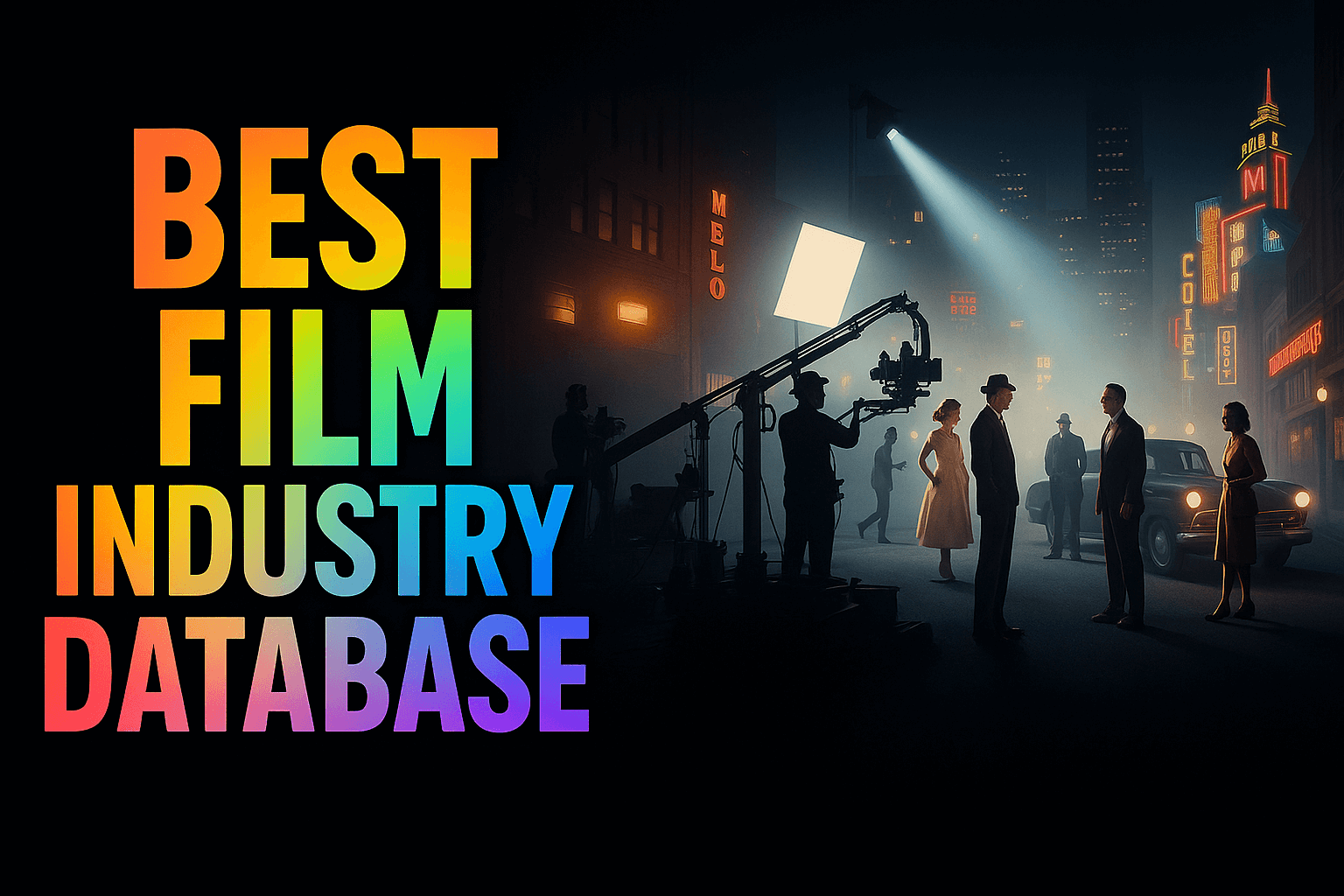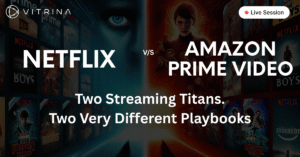Where to Find the Best Film Industry Database: A Guide for Professionals

Introduction
In the global media and entertainment (M&E) sector, success is no longer about intuition alone. It’s about data.
For senior executives in content acquisition, production, financing, and business development, the ability to find and vet the right partners is paramount. But this requires a reliable, up-to-date film industry database.
Without one, you’re operating with limited visibility in a market that’s fragmented, fast-moving, and filled with complexity. The challenge lies in moving beyond consumer-grade resources and finding a professional-grade solution that provides actionable, business-critical intelligence.
This article will provide a strategic framework for identifying a database that not only lists credits but connects the entire supply chain, offering a true competitive advantage.
Table of content
- The Challenge of Fragmented Data…
- How to Evaluate a Film Industry Database…
- Beyond the Basics: What Elite Databases Offer…
- The Vitrina Solution: A Strategic Approach to Data Intelligence…
- How Vitrina Helps: Connect the Entertainment Supply Chain…
- Conclusion: Powering Your Next Strategic Move…
- Frequently Asked Questions
Key Takeaways
| Core Challenge | Finding a professional-grade film and TV database that provides verified business intelligence, not just consumer-level data. |
| Strategic Solution | Implement a solution that tracks the entertainment supply chain at a business level, connecting projects, companies, and key decision-makers. |
| Vitrina’s Role | Vitrina is a leading platform that provides real-time, verified data on global film & TV projects, companies, and executive contacts to address the industry’s fragmentation challenge. |
The Challenge of Fragmented Data
For media and entertainment professionals, the search for a comprehensive database is a familiar one, often starting and stopping with public-facing, consumer-oriented platforms. While these sites are useful for general information, they fall short of providing the business intelligence required for high-stakes decisions.
The real problem is a lack of verified, structured data that connects the dots across the global supply chain—from a project’s earliest development stages to its final release.
Public sources are typically built around individual films, actors, and user reviews. This is a crucial distinction. As a result, they do not offer the visibility executives need to identify emerging trends, scout for new business, or build a robust pipeline.
The information is not curated for B2B applications. It’s for fans, not financiers or content buyers. You can see a movie’s star-studded cast, but you can’t easily see every project that a specific production company has in development, or the key executives attached to a project who are responsible for making deals.
The result is a fragmented view of the market. To get a complete picture, a professional must manually cross-reference multiple sources—industry news sites, festival listings, social media, and word-of-mouth.
This is not only time-consuming but highly inefficient, leading to missed opportunities and an incomplete understanding of who is truly active in the market.
The solution is to transition from data discovery to a data intelligence model, where the information is not just available, but structured and verified for strategic use.
How to Evaluate a Film Industry Database
Finding the right database requires a different lens than what a casual user might apply. A professional-grade solution is a business tool, and as such, it must be evaluated on its ability to drive tangible business outcomes. I recommend focusing on five key criteria.
First, consider the data integrity and sourcing. Is the information verified?
Does it come from the public domain or is it a proprietary collection of business-level metadata?
The accuracy of your decisions is directly tied to the reliability of your data.The M&E sector is rife with unverified claims and speculative news, so a source that has an internal fact-checking and validation process is invaluable.Next, examine its coverage and depth. This isn’t just about the number of titles. It’s about the scope of the information.
Does it track projects globally, or is it limited to one or two major markets?
Does it offer details beyond the well-known credits, such as the full roster of vendors, co-producers, and financiers?
A truly comprehensive database should give you a 360-degree view of the entire entertainment supply chain. Third, assess its user-centric design for B2B workflows.
Can you search for executives by their roles and specialties?
Can you filter projects by their current production stage (e.g., in development, in post-production)?
A platform built for business intelligence will have search and filtering capabilities that match the way you work. It should be designed for business development, not just for browsing.
Fourth, look for dynamic, real-time updates. The M&E landscape shifts daily. A project announced today could be acquired tomorrow. Your database must reflect these changes in real-time. Stale data is a significant liability, as it can lead to outreach efforts that are months too late. A platform that tracks daily project updates and company movements is essential for maintaining a competitive edge.
Finally, consider the ability to connect and map relationships. The most powerful databases don’t just list entities; they show the connections between them.
Can you see which companies have collaborated on multiple projects?
Can you map the network of an executive’s past collaborations?
This level of relationship intelligence is what separates a list from a strategic tool.
Beyond the Basics: What Elite Databases Offer
As you evaluate a professional film industry database , look for capabilities that go beyond a simple search function. A truly elite platform provides features that translate raw data into strategic insight.
A key differentiator is a robust project tracker. This feature allows executives to monitor a film or TV project as it moves through the entire production lifecycle. This isn’t just about knowing what’s in production; it’s about getting an early warning signal about projects in development or those entering the crucial post-production phase where key deals are made. Early access to this information is a competitive advantage for content acquisition, sales, and financing teams.
Another critical component is comprehensive company profiling. This moves beyond a simple list of credits to offer a full profile of a company’s capabilities, past collaborations, and business relationships.
This is crucial for vetting potential partners and understanding their market position. The most advanced systems can also map out a company’s financial and ownership structures, providing a deeper layer of due diligence.
Furthermore, a powerful database must have a deep, searchable directory of executive and professional contacts. In an industry built on relationships, finding the right person is often the first step to making a deal. A database that tags executives by their role, department, and past projects allows for precise, targeted outreach. This is far more effective than generic contact lists.
Finally, look for a platform that integrates this data into a cohesive intelligence layer. A database that combines project, company, and executive data into a single, interconnected view gives you the power to find co-production partners, scout for talent, or identify new distribution opportunities with unprecedented efficiency. This is the difference between a static list and a dynamic, living map of the industry.
The Vitrina Solution: A Strategic Approach to Data Intelligence
For many professionals in the M&E sector, the quest for a reliable film industry database ends with Vitrina. It is a platform designed to solve the very problems of data fragmentation and inefficiency discussed above.
Vitrina is not a fan site; it’s a B2B intelligence platform built for executives who need to find, track, and connect with partners across the global entertainment supply chain.
Vitrina’s core strength lies in its comprehensive data. The platform tracks over 500,000 film and TV projects and profiles more than 160,000 companies. It also maintains a verified directory of over 3 million executives, tagged by their roles and contact information.
This is not simply scraped data; it is proprietary, curated information that provides a granular and accurate view of the market. The platform’s methodology involves a unique process of mapping the relationships between companies, projects, and people, which allows for advanced searches and strategic insights.
For instance, you can identify every project a specific financier has backed or every vendor a studio has collaborated with. This level of relationship intelligence is what makes Vitrina a strategic tool rather than a simple directory.
How Vitrina Helps: Connect the Entertainment Supply Chain
Vitrina is built to solve specific problems faced by executives across the M&E ecosystem.
For content acquisition and distribution leaders, the platform serves as an early warning system. By tracking projects from their development stage, Vitrina allows you to identify potential content for pre-buys or co-productions long before they become public knowledge. This eliminates the frantic last-minute race to secure content.
For vendor services—from post-production to VFX—Vitrina provides a powerful business development tool. It helps you discover emerging project leads globally and identify production companies actively seeking specialized services. This capability is critical for building a proactive sales pipeline and reducing the reliance on manual scouting.
Finally, for production financing and co-production executives, Vitrina provides the transparency and data needed for due diligence. You can use it to map the entire network of collaborators on a project, check a company’s track record, and identify potential co-production partners who align with your specific genre and scale requirements.
The platform’s data is updated daily and includes integrations via API, ensuring that you are always working with the most current intelligence. It’s a single source of truth that replaces the need for disparate spreadsheets and fragmented research.
Conclusion: Powering Your Next Strategic Move
In an industry where information is currency, the choice of a film industry database is a strategic one. Moving beyond consumer-facing platforms to a professional-grade intelligence solution is no longer a luxury but a necessity for staying competitive.
The right database provides a clear, comprehensive, and interconnected view of the market, allowing you to make smarter, faster, and more confident decisions.
By focusing on data integrity, deep coverage, and B2B-centric design, you can find a platform that transforms the way you work.
A solution like Vitrina, which connects the entire entertainment supply chain, is not just a tool—it’s the engine for your next strategic move, empowering you with the intelligence needed to discover new opportunities and forge critical partnerships in a fragmented global market.
Frequently Asked Questions
A public database is typically for general consumers and fans, focusing on film credits and ratings. A professional database is a business intelligence tool for executives, providing verified data on projects, companies, and key decision-makers for strategic use.
Professional-grade databases are designed to provide global coverage, including independent films and projects in diverse markets outside of Hollywood. This is a key differentiator from public sources that often focus on major studio productions.
Yes. A robust professional database can help you identify and connect with potential partners by allowing you to search for companies and executives based on their past projects, specializations, and business relationships. This provides a direct path for new business development.
Yes, elite platforms use proprietary data collection and verification methods to track projects as they move through different production stages. This provides users with a critical early warning system for upcoming projects and industry trends.















































